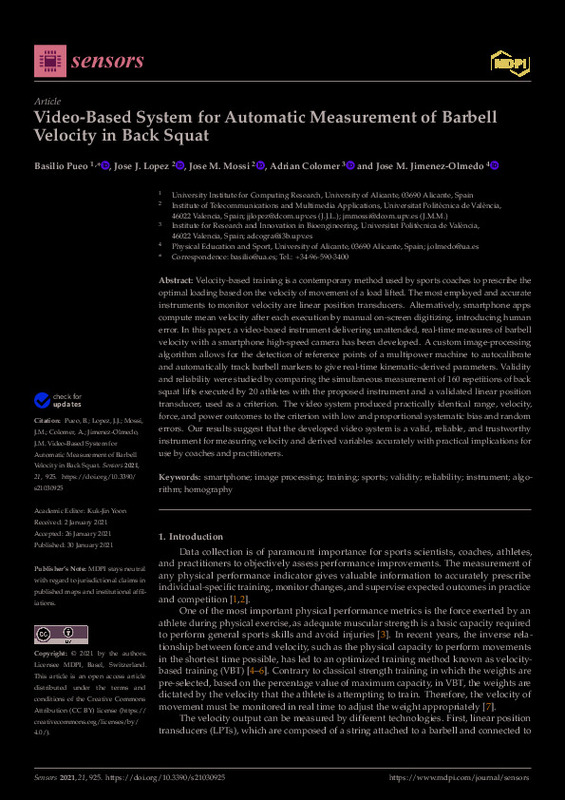JavaScript is disabled for your browser. Some features of this site may not work without it.
Buscar en RiuNet
Listar
Mi cuenta
Estadísticas
Ayuda RiuNet
Admin. UPV
Video-Based System for Automatic Measurement of Barbell Velocity in Back Squat
Mostrar el registro sencillo del ítem
Ficheros en el ítem
| dc.contributor.author | Pueo, Basilio
|
es_ES |
| dc.contributor.author | López Monfort, José Javier
|
es_ES |
| dc.contributor.author | Mossi García, José Manuel
|
es_ES |
| dc.contributor.author | Colomer, Adrián
|
es_ES |
| dc.contributor.author | Jimenez-Olmedo, Jose M.
|
es_ES |
| dc.date.accessioned | 2022-06-21T18:04:28Z | |
| dc.date.available | 2022-06-21T18:04:28Z | |
| dc.date.issued | 2021-02 | es_ES |
| dc.identifier.uri | http://hdl.handle.net/10251/183538 | |
| dc.description.abstract | [EN] Velocity-based training is a contemporary method used by sports coaches to prescribe the optimal loading based on the velocity of movement of a load lifted. The most employed and accurate instruments to monitor velocity are linear position transducers. Alternatively, smartphone apps compute mean velocity after each execution by manual on-screen digitizing, introducing human error. In this paper, a video-based instrument delivering unattended, real-time measures of barbell velocity with a smartphone high-speed camera has been developed. A custom image-processing algorithm allows for the detection of reference points of a multipower machine to autocalibrate and automatically track barbell markers to give real-time kinematic-derived parameters. Validity and reliability were studied by comparing the simultaneous measurement of 160 repetitions of back squat lifts executed by 20 athletes with the proposed instrument and a validated linear position transducer, used as a criterion. The video system produced practically identical range, velocity, force, and power outcomes to the criterion with low and proportional systematic bias and random errors. Our results suggest that the developed video system is a valid, reliable, and trustworthy instrument for measuring velocity and derived variables accurately with practical implications for use by coaches and practitioners. | es_ES |
| dc.description.sponsorship | This work was supported by the Vice-rectorate program of Research and Knowledge transfer for the Promotion of R&D at the University of Alicante (Ref. GRE18-09). | es_ES |
| dc.language | Inglés | es_ES |
| dc.publisher | MDPI AG | es_ES |
| dc.relation.ispartof | Sensors | es_ES |
| dc.rights | Reconocimiento (by) | es_ES |
| dc.subject | Smartphone | es_ES |
| dc.subject | Image processing | es_ES |
| dc.subject | Training | es_ES |
| dc.subject | Sports | es_ES |
| dc.subject | Validity | es_ES |
| dc.subject | Reliability | es_ES |
| dc.subject | Instrument | es_ES |
| dc.subject | Algorithm | es_ES |
| dc.subject | Homography | es_ES |
| dc.subject.classification | TEORIA DE LA SEÑAL Y COMUNICACIONES | es_ES |
| dc.title | Video-Based System for Automatic Measurement of Barbell Velocity in Back Squat | es_ES |
| dc.type | Artículo | es_ES |
| dc.identifier.doi | 10.3390/s21030925 | es_ES |
| dc.relation.projectID | info:eu-repo/grantAgreement/UA//GRE18-09/ | es_ES |
| dc.rights.accessRights | Abierto | es_ES |
| dc.contributor.affiliation | Universitat Politècnica de València. Departamento de Comunicaciones - Departament de Comunicacions | es_ES |
| dc.description.bibliographicCitation | Pueo, B.; López Monfort, JJ.; Mossi García, JM.; Colomer, A.; Jimenez-Olmedo, JM. (2021). Video-Based System for Automatic Measurement of Barbell Velocity in Back Squat. Sensors. 21(3):1-20. https://doi.org/10.3390/s21030925 | es_ES |
| dc.description.accrualMethod | S | es_ES |
| dc.relation.publisherversion | https://doi.org/10.3390/s21030925 | es_ES |
| dc.description.upvformatpinicio | 1 | es_ES |
| dc.description.upvformatpfin | 20 | es_ES |
| dc.type.version | info:eu-repo/semantics/publishedVersion | es_ES |
| dc.description.volume | 21 | es_ES |
| dc.description.issue | 3 | es_ES |
| dc.identifier.eissn | 1424-8220 | es_ES |
| dc.identifier.pmid | 33573170 | es_ES |
| dc.identifier.pmcid | PMC7866505 | es_ES |
| dc.relation.pasarela | S\429682 | es_ES |
| dc.contributor.funder | Universidad de Alicante | es_ES |








